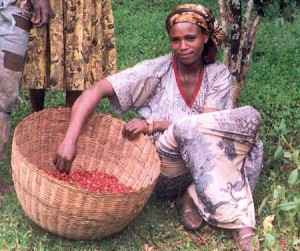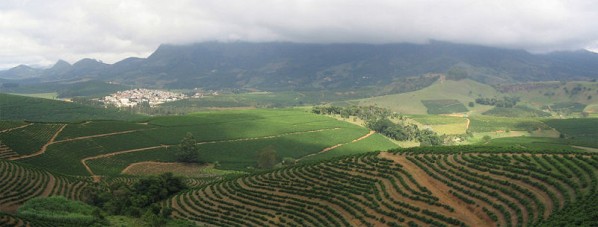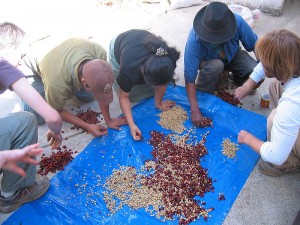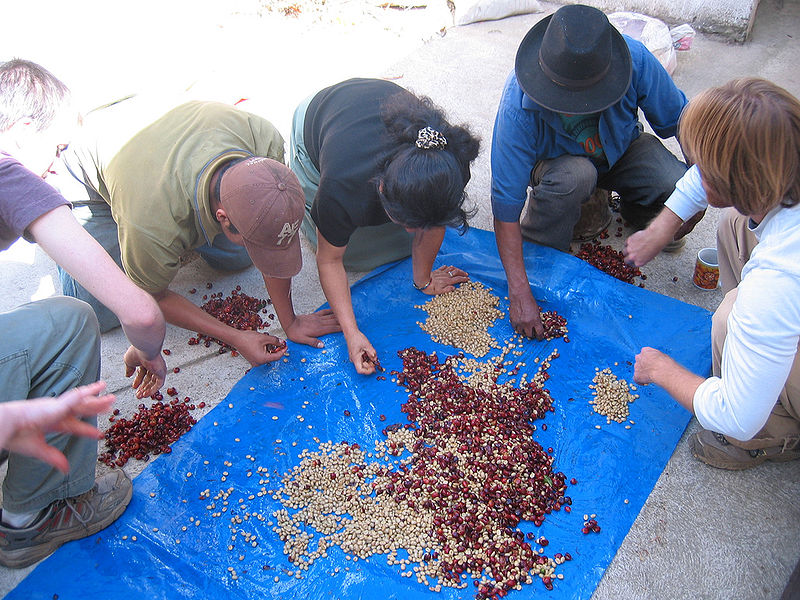You now know from “Coffee and You: Part 1” that coffee won’t kill you, but don’t drink that cup entirely guilt free yet. First introduced as a beverage around the 15th century in Ethiopia1, coffee has remained a popular drink and green coffee (aka unroasted coffee) is currently one of the most highly traded agricultural commodities in the world2. An estimated 25-100 million farmers and their families are supported

by coffee growing, most of whom grow the beans on small farm lots. Coffee trees are picky growers, requiring deep and acidic soil, high altitudes, moderate temperatures, and 1200-1500mm of annual rainfall3. These specific conditions explain why most coffee grows in tropical areas, such as South America and tropical Asia. Most of these regions include developing nations, and the coffee trade has proven both a blessing and a curse for farmers relying on it as their crop. As such a profitable plant, coffee farmers and their land have been exploited for these prized beans. Alongside its rising popularity has been a surge of environmental and humanitarian concerns over its cultivation and export.
Traditionally, coffee trees were naturally raised under the shade of the canopy, known as the “shade-grown” method, where the coffee berries (called “drupes” by botanists) take longer to mature and yield lower quantities of high quality coffee. This method also supports biodiversity by providing a habitat for various plant and animal species, and can be performed using little to no pesticides or fertilizers4. Beginning in the 1970s, however, farmers switched to a different growing technique known as “sun cultivation”. Coffee trees are instead planted in large, arrayed plantations with full sun exposure. The result is a rapidly ripened and high yielding coffee tree, at the expense of deforestation, heavy water use, and chemical pollutants from pesticides and fertilizers5.

As the demand for coffee continues to increase, questions over the sustainability of these practices have surfaced. Sustainability refers a growing practice in which biodiversity is preserved, chemical input is minimized, resources are conserved, and production is efficient, commercially competitive, and beneficial to the farmers and society at large6. In efforts to elevate these

problems, the Fair Trade movement was established in the early 1990s to promote improved trading conditions for developing nations and sustainable practices for products like coffee, tea, bananas, handicrafts, and others. The social implications include better profits to producers and tighter connections between their customers, thereby reducing the “middlemen”7. This description is certainly not all inclusive of their key principles, which are better summarized here or directly on the Fair Trade website. Fortunately, Fair Trade certified sales have been increasing, and many corporations such as Starbucks have Fair Trade products available. Nevertheless, a great deal of controversy surrounds the efficacy of Fair Trade. If you’re interested in learning more about Fair Trade, for better or for worse, please feel free to comment below and I’d happily discuss it in greater detail.
To do your part, follow a few of these guidelines8 when making your coffee purchasing decisions:
Certification.
Not all sustainable coffees necessarily carry a seal, since certification costs a lot of money. Fair Trade coffee is great when considering social issues, but not necessarily environmental issues (although it’s certainly better than nothing!). So, if you want full assurance that your coffee is grown with the highest environmental and humanitarian standards, here is what to look for:
1. The best label to encounter is one deemed bird-friendly by the Smithsonian Migratory Bird Center, which requires the most stringent environmental standards and is also certified organic. For their full criteria, click here.
2. Organic certification by accredited agencies promises that many chemical inputs are minimized or eliminated, and generally organically grown coffee is shade-grown.
3. Rainforest Alliance certification guarantees environmental protection but not necessary organic practices. Certification from this agency isn’t all or nothing either– many coffee varieties claiming to be certified through Rainforest Alliance may only have, say, 25% of their beans certified. So be sure to look for labels stating “100% Rainforest Alliance Certification”. For their full criteria, click here.
Where it’s from.
Some countries are more likely to grow shade-grown varieties than others, so when selecting your coffee be sure to check its

country of origin (remember, shade-grown is more environmentally sustainable).
Likely Shade-Grown: Mexico, El Salvador, Nicaragua, Honduras, Bolivia, Papua New Guinea, and Ethiopia.
Likely Sun-Grown (unless indicated otherwise on the label): Costa Rica, Brazil (the largest coffee exporter), Colombia, and Vietnam.
** Botanical variety (for example, Arabica versus Robusta) is a useful indicator as well.
PRICE!
All these assurances do translate to higher coffee prices for the consumer. I know, I know. When presented with a $5/lb bag of coffee versus a $9+/lb bag, it’s hard not to opt for the former given our undoubtedly cheap budgets. Nevertheless, you’re not being a conscientious consumer if you do. Cheap coffee suggests it is sourced from big, unsustainable monoculture plantations. Importantly, the farmers providing this mass-produced, chemical-ridden coffee receive the lowest wages—sometimes as low as $0.25/lb, which is utterly outrageous. Declines in coffee prices force small farmers to either switch to less ecologically sound farming tactics, or abandon their farm altogether to be taken over by loggers, ranchers and/or conventional farmers. Clearly, this is unprofitable and unfair for these farmers, and can be a huge contribution to the economic crisis many of these countries are experiencing.
Think of it this way though: If you end up buying coffee at shops often, consider of the amount of money you’re wasting anyways. Instead, buy the expensive bag of coffee that you know is environmentally- and socially-friendly, brew it at home, and try to be better about bringing your own coffee to class or whatever. It’ll save you that 2- something-dollars each time, reduce waste from the coffee cups, and come from a good source. Plus, you can experiment with different varieties and see how much tastier the finer stuff is!
So you know how it’s grown, but do you ever wonder about the final preparations of those fragrant beans you’re buying at the store? It’s quite fascinating, so stay tuned for a continuation of our coffee series!
_________________________________
References
Special thanks to Cait Murphy for sharing some resources from her Environmental Science class! And thanks to Becca Tarvin, as always, for helping me find applicable information!
1. Pankhurst, Richard (1968). Economic History of Ethiopia. Addis Ababa: Haile Selassie I University. p. 198.
2. Pendergrast, Mark (April 2009). “Coffee second only to oil?”. Tea & Coffee Trade Journal. Retrieved December 29, 2009.
3. Coffee Research Institute. The Optimal Coffee Environment: Best Climate Conditions for Growing Coffee Beans. http://www.coffeeresearch.org/agriculture/environment.htm
4. “Shade-Grown Coffee Plantations”. Smithsonian Zoological Park website – Migratory Bird Center. Smithsonian Institution. Retrieved March 29, 2010.
5. Salvesen, David (1996). “The Grind Over Sun Coffee”. Zoogoer. Smithsonian National Zoological Park. Retrieved March 29, 2010.
6. Smithsonian Migratory Bird Center, First Sustainable Coffee Congress overview paper, Russel Greenberg. http://nationalzoo.si.edu/SCBI/MigratoryBirds/Coffee/thoughtpaper.cfm
7. Fair Trade Federation. http://www.fairtradefederation.org/
8. Coffee and Conservation: Are your beans for the birds? http://www.coffeehabitat.com/
** A TERRIFIC and well-researched website for all coffee-related questions!

